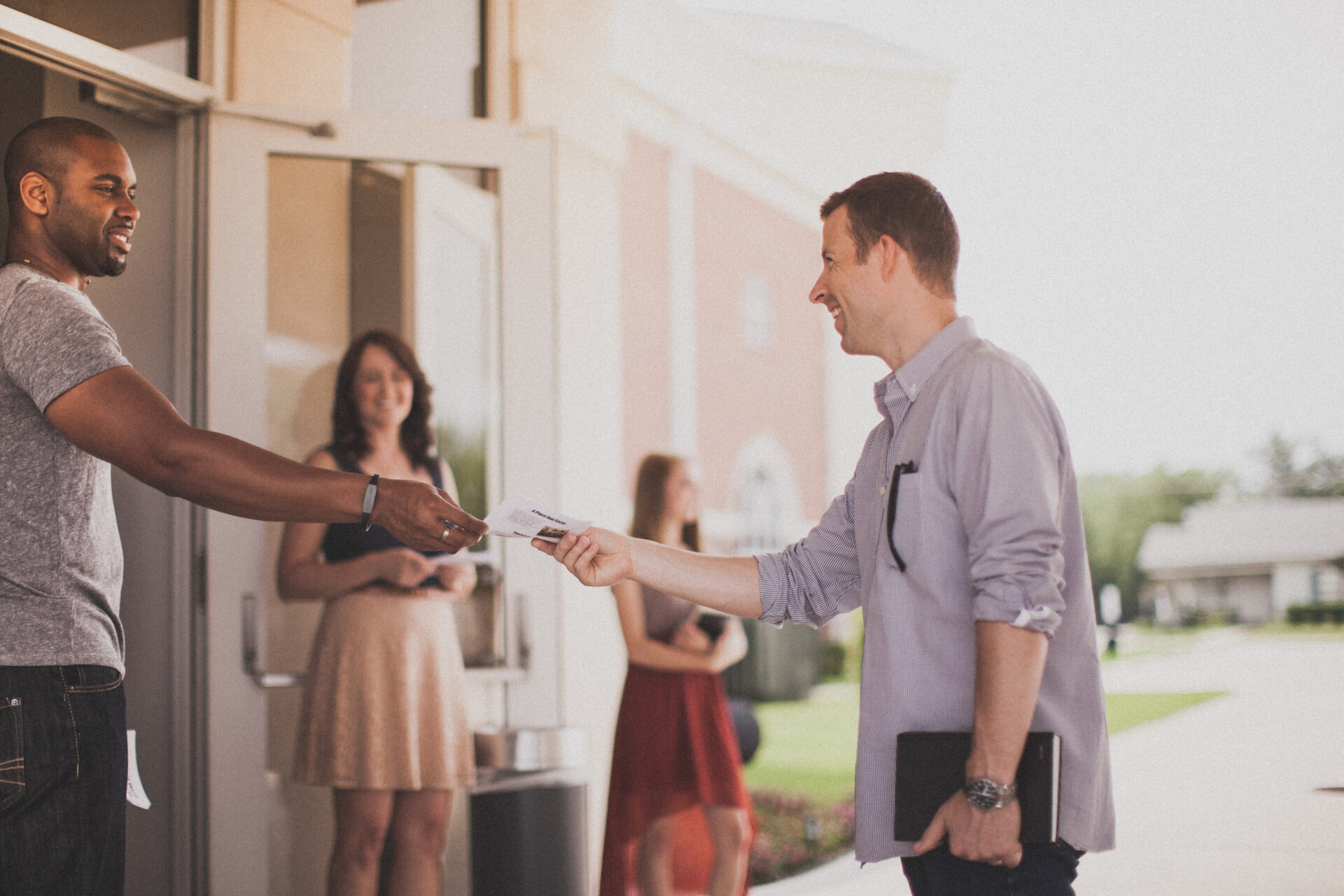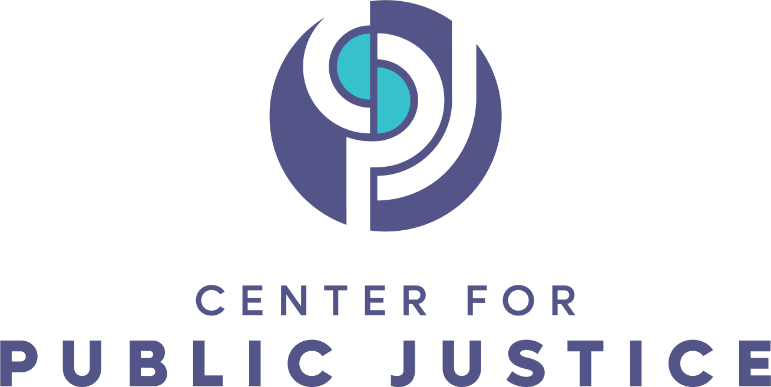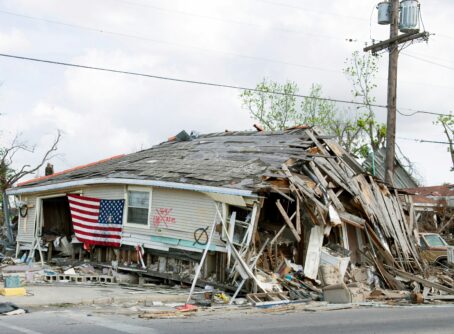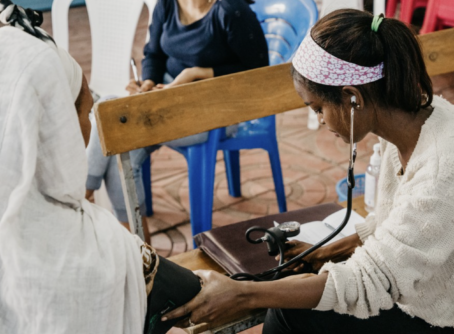
This article is the first in our series looking at the Invisible Social Safety Net — all of those houses of worship and faith-based organizations that provide essential social services to their communities, sometimes with the help of government funding and sometimes without that assistance. In order to unleash the power of the social safety net to support our most vulnerable neighbors, CPJ advocates for state, local, and federal governments who need to understand how to partner with and support these “invisible” links who serve not because they have to by law, but because faithfulness to their tradition calls them to serve.
In the midst of the COVID-19 pandemic, my church turned its lobby space into a food drive staging area. Members of the community (and the church) were able to drive up outside the lobby as masked and gloved church volunteers brought bags of groceries and household supplies outside and placed them in the trunks of the cars that pulled up to the church. Watching my church serve its neighbors in this way gave me eyes to see the critical role that houses of worship can play as a part of the social safety net. This was not the first time I had considered the importance of faith-based organizations (FBOs) as high tenacity fibers in the safety net, but the church food drive certainly made a lasting impression.
When you think about the social safety net — if you think about it at all — houses of worship or FBOs may not be top of mind. Perhaps you would imagine a network of federal and state government programs that provide for the welfare of the most vulnerable in our communities. In line with this image, The Brookings Institution defines the social safety net as:
“A collection of programs designed to support families experiencing financial hardship. The design of some of the programs is largely determined by the states, while others have structures and benefits largely determined at the federal level.”
This is a good working definition, but with its focus on government programs it leaves out a large, underreported network of social service providers. Most definitions of the modern social safety net stress government programs like Supplemental Nutrition Assistance Program (SNAP), or the Special Supplemental Nutrition Program for Women, Infants, and Children (WIC) and neglect how important the programs provided by faith-based and secular civil society organizations are–programs they often fund themselves but sometimes operate in partnership with government.
I would like to challenge all of us to think more inclusively about the critical social services provided by faith-based organizations. What if the government programs listed above are only the most visible fibers of a larger safety net in the United States? What if we are missing an important part of the safety net story?
With this article, the Center for Public Justice is starting a new series of articles, entitled, “The Invisible Social Safety Net.” Unless we are deeply familiar with the full landscape of social services in the U.S., we may miss the fact that many houses of worship and faith-based social service providers constitute essential links in the social safety net. Ironically, despite concentrated effort over the past three decades to ensure their eligibility for government funding, these faith based organizations rarely receive government funding or coordination despite the services they provide.
Faith-based organizations are the backbone of the social safety net in the United States, providing essential services.
Faith-based organizations are the backbone of the social safety net in the United States, providing essential services. Many churches, mosques, and temples provide services like food pantries, addiction treatment, clothing drives, job application assistance, transportation, healthcare services, workforce development, child care, and housing. In fact, according to the U.S. Department of Housing and Urban Development, faith-based organizations account for at least half of all food assistance distribution programs to unhoused individuals and families in the U.S. They also account for roughly one quarter of housing programs for unhoused individuals and families. Houses of worship and FBOs provide many of these services out of their own buildings and in the neighborhoods closest to where some of the most vulnerable members of our communities live.
There may even be more houses of worship — a subset of faith-based organizations — that provide critical social services in their communities than many currently realize. The National Congregations Study has some interesting data on the percentage of congregations—including mosques, synagogues, and churches—that are active in providing social services. Their most recent data from 2018-19 shows that 14.3% of congregations offer services to immigrants, 26.6% help the unemployed find a job, 42.8% have programs that assist people struggling with substance abuse, 26.2% support people who are experiencing mental health challenges, and 48.2% volunteer or do service work with people who have a different faith.
These statistics reveal a deep commitment from faith communities to serving their neighbors. They may have few resources, but their resolve to serve is strong and they know how to stretch every dollar and maximize each donation. What would happen if these FBOs and houses of worship were able easily to partner with federal, state, and local governments to exponentially increase the funding and resources available to FBOs already providing social services?
In 1994, the Center for Public Justice was asking this very question. Stanley Carlson-Thies and Jim Skillen hosted a conference for scholars and policymakers in Washington, D.C. entitled, “Public Justice and Welfare Reform” as part of CPJ’s Welfare Responsibility Inquiry Project. Out of the Welfare Responsibility Inquiry, the Center for Public Justice came to three main conclusions. First, CPJ observed that there are different kinds of poverty and that welfare programs ought to take into account not only the net worth of an individual, but also his or her social capital and potential future income. For example, if we look at the net worth of a college student and the net worth of a senior citizen who has large medical bills, their net worths might not look all that different. However, we might be able to draw the conclusion that the college student’s potential to earn and network of support might be far greater than that of the senior citizen. Measures of poverty that look only at net worth might miss other important indicators of poverty such as social capital, ability to earn, discrimination against certain job seekers, health, and more.
Second, CPJ recognized that civil society organizations are really important when it comes to providing effective social services. Consequently, when government has the opportunity to partner with civil society organizations and does, CPJ found that those welfare programs flourished.
Lastly, CPJ found that faith-based organizations play a very important role in providing culturally competent care. Because many faith-based programs align with their participants’ spiritual beliefs and worldview, they found that participants experience a ripple effect of outcomes. They discovered that faith-based programs may be better suited for lasting transformation and building up social capital through a sense of community for those to whom faith is important.
The Welfare Responsibility Inquiry came to the conclusion that asking the question of whether or not there should be more government funding for welfare programs or less completely missed the point. Instead, Carlson-Thies and other scholars discovered that pairing individuals to community-based organizations that matched their values and provided a network of support was often the key to successful program outcomes. You can find much of their work in the book, Welfare in America and CPJ’s Guideline on Welfare that came out of this inquiry. Faith-based programming or the “faith factor,” as so many academics and journalists later came to call it, has the potential to make a dramatic difference in the lives of program participants and beneficiaries.
Because many faith-based programs align with their participants’ spiritual beliefs and worldview, they found that participants experience a ripple effect of outcomes.
The discovery that persistent poverty and other social challenges often are multidimensional and can best be addressed in multidimensional ways warmed up policymakers and scholars to the idea that government programs would be better if they operated in partnership with faith-based as well as community-based organizations. During this same time, the Supreme Court was re-evaluating its church-state doctrine, moving away from a “no aid to religion” separationism to an equal treatment standard.
Combined, these trends prompted interest in revising the rules accompanying federal funding for social services. Was there a way for the government to provide funding to faith-based social service programs and to houses of worship without requiring an unconstitutional obligation that people needing help are forced into religious practices? Subsequent articles in this series will explore how houses of worship have been able to navigate utilizing federal or state funding for social service programs without imposing religious requirements on participants.
In 1995-96, CPJ supported church-state scholar Carl Esbeck when he pitched an idea to Senator Ashcroft called Charitable Choice. Charitable Choice required equal opportunity for faith-based organizations to receive government funding, protection of the religious identity of those organizations, and protection of the religious freedom rights of people seeking help. Sen. Ashcroft then introduced the idea into the Senate debate on welfare reform, and Charitable Choice was included as a part of the The Personal Responsibility and Work Opportunity Reconciliation Act adopted into law in 1996. With regard to the legal rules, Charitable Choice leveled the playing field for FBOs in the federal grant-making process.
How has Charitable Choice impacted public/private partnerships for faith-based organizations today? It turns out that much more is needed than only legal changes to expand partnerships between government and faith-based organizations. For example, the 2018-2019 National Congregations Study estimates that although 79.6% of congregations participated in providing at least one social service program in the past two years, only 4% of congregations had applied for a government grant. This means that the vast majority of houses of worship that make up the social safety net are not receiving government funding to supplement part of social services they provide.
Why such a difference between a formally level playing field and the rather limited number of churches and other FBOs that receive government funding? Well, there’s an invisibility to the work that FBOs do and a difficulty in creating partnerships with the government because those FBOs aren’t necessarily focused on securing government money or inflating their public profile. Indeed, rather than spending money on government grant-writing teams or on PR, the staff and volunteers of FBOs are focused on serving their local communities, which often means that the stories of transformation, renewal, and healing that they see every day go unnoticed by the public and even by some people in their own communities. Additionally some organizations forgo federal funding because they want to preserve the integration of faith in their services.
To expand partnerships notwithstanding these and other hampering factors, governments developed what has come to be called the “faith-based initiative.” This is a set of federal, state, and local efforts to change how government programs operate, how grants are advertised and awarded, and how civil society organizations find out about opportunities to work with government. Charitable Choice paved the way for the additional government support of faith-based initiatives at the federal level. After the law passed, many states and municipalities implemented reform measures and built new partnerships. Although, as CPJ has previously pointed out, many states received a failing score for implementation of Charitable Choice, which with help have worked to correct.
Building off of this momentum, in 2001, the Bush Administration established a White House Office of Faith-Based and Community Initiatives, opening up new avenues for FBOs to partner with government agencies to serve their communities. Each subsequent administration has established some form of this office. During the Trump Administration, the White House opted to have a Faith-Based Initiative Advisor. In 2021, the Biden administration quickly reestablished the White House Office of Faith-Based and Neighborhood Partnerships. The next presidential administration should consider quickly reestablishing the White House Office of Faith-Based and Neighborhood Partnerships as a way to support faith communities and the social safety net.
The government should also continue to support a legal environment that protects religious nonprofits so that they are free to serve. As my colleague Carlson-Thies recently wrote, “laws that restrict or protect religious freedom are adopted at the state and not only at the federal level. Thus, to know how well the religious freedom of people and organizations is being protected, it is essential to look closely at state policies and not only action at the federal level.” The state governments especially must consider how religious freedom laws impact the ability of religious organizations to be free to serve.
The state governments especially must consider how religious freedom laws impact the ability of religious organizations to be free to serve.
At CPJ, we want to make sure to tell some of these powerful stories about the impact that faith-based organizations providing social services can have in their communities. As a part of the Invisible Social Safety Net series, Christian young adults and college students from around the country will interview leaders at faith-based social service organizations and houses of worship from a range of religious communities to learn more about the work that they do and to give us eyes to see the invisible links in the social safety net.
When it comes to serving those who need it most in the U.S., houses of worship and faith-based organizations are at the forefront of providing critical social services and their stories are waiting to be told. This series serves as a way to also illuminate for government officials (and scholars who study what the government does) to better understand FBOs and the goals and promises of faith-based initiatives and the ways their work naturally intersects with the government. I hope you will follow along with us as we explore the religiously, ethnically, and culturally diverse civil society institutions that make up the Invisible Social Safety Net.
Do you know someone who works at a social service organization doing fantastic work to create a safety net for the most vulnerable in our communities? Brag on your friends to us! We’d love to set up an interview. For more information you can reach out to Emily Crouch at emily.crouch@cpjustice.org.
Emily Crouch leads CPJ’s work with young people. She directs the Civitas Fellowship for Congressional Staff, a leadership development program for early-career Congressional staff.





